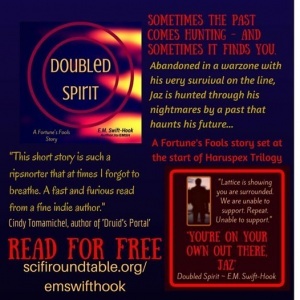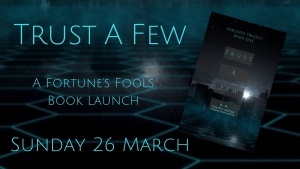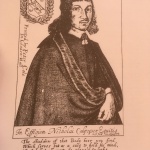Cindy Tomamichel's Blog: World Building, page 13
March 20, 2017
E.M.Swift-Hook – Author interview
Today I introduce E.M. Swift-Hook, a British writer from the North-East of England and author of the Fortune’s Fools series of space opera books. Her first trilogy of the series, ‘Transgressor’ came out last year.
E.M. is also one of the founding members of the facebook group ‘Scifi Roundtable’ and has been instrumental in helping many authors polish their work and achieve their dreams.
What is your current project?
Thanks for asking me along today, Cindy. Right now I’m just bringing out the first book in my new Haruspex Trilogy, which is set mostly in a megatropolis dominated by criminal syndicates, called the ‘City. The book is called ‘Trust A Few’ and it includes a couple of characters which will be familiar to anyone who has read Transgressor and some new friends and enemies for them. But Haruspex is very much a ‘stand-alone’ story, so if you have not dived into Transgressor, you can start with Trust A Few instead and hopefully enjoy the story just as much as someone who has.
 Click here for a fast and furious free short story from EM Swift-Hook
Click here for a fast and furious free short story from EM Swift-HookGive us a good one liner from your latest book
Wow, that’s a bit of a challenge off the cuff, but maybe this one, from my freighter pilot Charis, when she has been coerced into making an illegal run: “So here I am on a cargo shunt into a war zone with a creepy looper, a psycho killer, and the galaxy’s gift to womankind. My life is so good right now, I feel really lucky – privileged.”
What’s your favourite imaginary world that’s not your own?
I have so many! But my top one for sci-fi would have to be the Blakes 7 universe. There are definite tributes to that universe in Fortune’s Fools and it has to remain one of the founding pillars of my inspiration.
Tell us about a life experience that ended up in your fiction work
I’m not sure I can think of any specifically, although obviously all anyone writes about human relationships has to be drawn from real or vicarious life experiences. But I did draw on real life as inspiration for the plight Charis finds herself in when she faces deportation and has to leave her home and foster mother in the high-tech Central worlds as she is longer a lone child refugee.
Where do you get your inspiration and ideas?
I am not entirely sure they come from a specific place, more a generic blend of the stories I absorb, life as I witness and experience it, and the way the ambitions and motivations of my characters interact with the universe in which they live.
Name another author that you would recommend reading.
Have we got a few hours? Where to begin? There are some really amazing indie authors out there, people like Leo McBride, Jane Jago, Eric Michael Craig, Warren Dean, Brent Harris, Bonnie Milani, Kat Caffee, Robert Lee Beers and Chrys Cymri – the list goes on.
If you travelled in time, when would be your choice? Would you prefer magical or technological means of travel?
I’d probably head into the future a couple of hundred years or so – not too far, but enough that all the upcoming technology should have become embedded in society. I think going too far into the future would be too disorienting to even a sci-fi writer. As for means of transport, I don’t think I’d mind, as long as I knew it was safe.
Name 5 fictional characters you would invite to a dinner party.
Well I would enjoy meeting my own characters quite a lot, as long as they didn’t know I was their author or it could get very messy. So maybe I’ll just go for four – the main characters in ‘Trust A Few’: Durban, Jaz, Charis and Avilon. Not sure how well we would all get along though, we don’t really have a lot in common.
What is the next project?
The next project is bringing out ‘Edge of Doom’ and ‘A Walking Shadow’, the final two volumes in Haruspex Trilogy, hopefully by the end of the year.
How can people contact you to find out more?
You can follow my author page on Amazon, or if you want to keep up to date with my projects please subscribe to my blog.
Blog: http://scifiroundtable.org/emswifthook/
Author page: https://www.amazon.com/E-M-Swift-Hook/e/B01FL8FMI0
Twitter: https://twitter.com/emswifthook
Thanks for having me here, Cindy, and I must say you have some really fascinating articles on this blog. I was reading through the ones about what people might eat in a fantasy world, intriguing ideas. Can’t wait for Druids Portal to come out and see how you’ve put all this research and fantasy together.
E.M. also has a book launch party coming up on March 26th, and there are a lot of great writers coming along to discuss scifi and scifantasy. It’s a great chance to get to know some of the inside stories behind the books, and you will be able to ask all sorts of gnarly questions of the writers.
Click on the photo to arrive at the event!
 EM Swift Hook launch party
EM Swift Hook launch partyThe post E.M.Swift-Hook – Author interview appeared first on Cindy Tomamichel.
March 12, 2017
Review: David Grayson Adventures in Solitude
 Adventures in Solitude by David Grayson
Adventures in Solitude by David GraysonMy rating: 4 of 5 stars
I have long had a quote by David Grayson "Adventure is not outside a man, it is within", so I was thrilled to find a copy quite by chance. This is a great book, along the lines of Thoreau. It is a book for thinking and enjoying, and many lines will stay with you forever.
Plunged into sickness, the author recounts his inner journey from despair and hopelessness to absolute joy in the small and great things of life. The notion of a lifetime of reading making for a rich inner life that can be explored at leisure is the main theme he explores. Lying ill, his mind travels back into the great thoughts and poems and spends time teasing out the full richness and depth of meaning.
Grayson wrote many books, including some on political and racial topics, and in his time was an adviser to the president. While old fashioned, this book is one that can re inspire gratitude in the small things of life. It is well worth searching out and reading.
View all my reviews
March 7, 2017
Using Herbs in Fiction
Herbs have a long history of use, from pre written word days right up to the internet. They can add flavour, lifting a simple dish into one fit for royalty. So it is only fair to include them in your novel, where you may find they lift your descriptions in the same subtle way they do in real life. I have explored some real life uses of herbs, and ways in which other writers have used them in their novels. The scent and flavour of herbs is evocative and usually familiar, so you can mention a herb and immediately the reader will know without you having to tell them all about it.
Herbs in fiction – add a pinch of sensory enjoyment for readers.
Click To Tweet
Some excellent resources are available for herb use, from Culpeper’s original Herbal, where he discusses the doctrine of signatures. This was the belief that a herbs shape (leaf, flower or root) and its resemblance to a body part meant it was a sign from God that it was useful in problems relating to that organ. Others include Readers Digest ‘Magic and Medicine of Plants’ and ‘The Herb Bible.’ Make sure you use herbs bearing in mind their country of origin. Mediterranean herbs (rosemary, thyme, basil etc) are different to plants used as herbs in America or India for instance. This relates to a fantasy world climate just as much as an historical. With historical, you also need to find out if the herb was imported – many British plants were brought there by the Romans.
 Nicolas Culpeper
Nicolas CulpeperHerbal teas are common, used today for health as much as they ever were. Mint for digestion and flavour, sage, rosemary, lemon grass – all these are common and can be used by a character. In one popular fantasy series, Jean Auel’s Earth Children (Clan of the Cave Bear) her main character was a medicine woman, and herbs are an intricate part of the overall series.
Herbs in food can be used to add an element of interest. Questing elves, dwarves and barbarians can forage along the way and flavour a stew or porridge with sage, bay or wild garlic. Use rosemary stalks to baste a joint of meat over the fire, or throw woody herbs on the fire for their aroma and to repel insects. Many spices were expensive, so they can be used as a subtle indicator of wealth, or their transport can be woven into the story with ship or caravan transports and thieves.
For hygiene purposes, your heroines or dandies could use floral scents in various ways. Floral waters and oils using lavender, rose or jasmine, or perhaps stored clothes could smell of old lavender or sandalwood, a costly scented wood. Soapwort is a low growing plant that was once used to wash old tapestries, as its roots make a gentle lather when pounded in a mortar. Strewing herbs were popular in medieval times, where sweet rushes (iris), and other sweet herbs were left underfoot to reduce smells. Pomanders (oranges stuck with cloves) and tussie mussies (herb bouquets) were also used to cope with unpleasant smells, such a drains and sickrooms in Victorian times.
In a science fiction book, I can imagine herbs being a reminder of the home world. I was given a plastic tube once, and told by the marketer it held the essence of New Zealand. The scent was fresh grass – I can see this in an old freighter, being sniffed by a grizzled half cyborg veteran before launch. Andre Norton uses exotic spices as a trade item in many of her books, including strange coloured woods.
On darker topics, herbs can be used for ill. Herbs mashed into ointments gave women delusions of flying in witchcraft trials. The toxic rust ergot on rye grass was believed to be the cause of mass hallucinations at the Salem Witch trials. The smoke from burning herbs could give dreams and visions, such as the ancient oracle at Delphi. Some herbs are just flat out poisonous, as any reader of the Brother Cadfael series by Ellis Peters will be familiar. Even today, certain mushrooms are used as hallucinogens.
So, like herbs in real life, sprinkle them sparingly in your fiction.
(Photos from ‘Culpeper’s Complete Herbal and English Physician.’ reproduced from a 1826 edition, Magna Books.)
The post Using Herbs in Fiction appeared first on Cindy Tomamichel.
March 5, 2017
Review: As Far as my feet will carry me.
 As Far as My Feet Will Carry Me by Josef M. Bauer
As Far as My Feet Will Carry Me by Josef M. BauerMy rating: 4 of 5 stars
This is a fantastic tale of endurance and an insight into how a human will degenerate when on the edge of survival for a long time. While the writing style is a little dated, the elements of the story will keep you going thru blizzards, wolf attacks, starvation, you name it, he survived it.
The people he meets are well described, from the doctor that helps him, to the reindeer herding peasants. Most of the people he meets help him, which provides the better view of humanity. In contrast, the main character is as stubborn and unpleasant as you would need to be to do what he did and survive.
In a land where all hands are against him, Forell fights himself, the landscape and often the people to survive. The process is a glimpse into a mans character as civilisation is stripped from him day by day.
A compelling read, and even more so when you remember this is a true story.
View all my reviews
As Far as My Feet Will Carry Me: The Extraordinary True Story of One Man's Escape from a Siberian Labour Camp and His 3-Year Trek to Freedom
February 20, 2017
Book review: Twenty Thousand Leagues Under the Sea.
 Twenty Thousand Leagues Under the Sea by Jules Verne
Twenty Thousand Leagues Under the Sea by Jules VerneMy rating: 3 of 5 stars
This is an old classic, and it is starting to show it. While it is hard to fault the premise, for at the time it was a true original, the preferred writing style of an audience has changed a great deal. There is a great deal of action and some great scenes and characters, yet they get buried in between pages of descriptions of molluscs, fish, engine design and electricity generation.
Read it gently, and be patient. It does take you into a new world of the mysterious Captain Nemo, but it also takes you back to the 1870's, when adventure was served up with some detailed science. Most of his books are like this, so you may pick one based on your interest in geology (Journey to the centre of the Earth), engineering (Mysterious Island), or the depths of the sea.
There is no faulting his imagination, for these books have become entertaining movies. A great story will always survive, and without doubt this is a great story.
View all my reviews
February 12, 2017
New flash fiction story
I have recently had a flash fiction short story accepted by Underground Writers for their Issue 17, on the theme of travelling or hitch hiking.
Click here to go to the pdf. The entire issue is free to download, and there is some great poetry and stories in it.
Mine is ‘Bus Trip’ written in the second person, or the ‘you’ perspective. Hope you enjoy it and the other work in the magazine.
The post New flash fiction story appeared first on Cindy Tomamichel.
February 5, 2017
Barbarian Carbs
Making bread is a labour intensive process, and your average travelling barbarian or quest obsessed elves and dwarves have other things on their minds. Today we are in the same mindset, for buying a loaf of bread ignores the efforts involved in tilling and fertilising a field as well as protecting it from pillaging soldiers. Not to mention the work your ancestors put in selecting, evolving and planting a suitable grain for your climate. Then there is harvesting, threshing, winnowing and storage. But the rewards were great – bread, scones, pancakes, then cakes, pies, donuts… the list of carb based tastiness never ends.That’s why we stopped being hunter gatherers and settled down in villages. Dreaming of donuts, we descended from the trees to the savannah grasses.
Dreaming of donuts, we descended from the trees to the savannah grasses.
Click To Tweet
Aside from stealing or buying bread, chewing on a crust as they gaze moodily off into the distance, your barbarian has a few choices. They can use sour dough, carrying the starter fermenting yeast with them. This is obviously more likely in the caravan or family travelling scenario, where the starter mixture is used to make the next batch rise due to natural yeast action.
However, carrying flour is more likely, and here our hero could take some time to make soda bread if baking soda is available. With a few hot rocks, some unleavened dough could be cooked. If a cookpot is handy then our fantasy characters can get creative and make dumplings. Using flour, water, a bit of fat and salt, and some herbs plucked in passing, our worthy adventurers would sleep well on a full stomach of stew and dumplings. A porridge of grains is another standby, although whole grains would need soaking overnight, and a long boiling time, necessitating wood for a fire and time to cook it.
One famous fantasy bread is lembas, the honey flavoured bread of Tolkien’s elves. It travels wells, tastes like heaven, and will sustain you through Mordor. The other end of the spectrum is Terry Pratchett’s dwarf bread, which has its own museum in Ankh Morpork. He describes it as something you always have with you, and no matter how hungry you are, the extremely inedible appearance will take away your appetite. Nanny Ogg makes a batch, with the main ingredient being the cat litter tray. It is also famous for being hard enough to use as a weapon, which makes it a handy thing to have in the warrior’s sporran.
In real life, hardtack or ships biscuit were used. Both of these are basically flour, salt and water, rolled and hard baked. These would keep for a long journey, although weevil infestation was common. CS Forester gives Hornblower the automatic habit of tapping the biscuit on the table to encourage the weevils to leave before eating. Otherwise it could be used as a soup thickener or porridge like gruel with some flavouring such as salt pork. The Australian standby of damper, which is flour, salt, bicarbonate of soda and water was an another quick loaf to bake while the rest of the meal was cooking.
https://en.wikipedia.org/wiki/Hardtack
The post Barbarian Carbs appeared first on Cindy Tomamichel.
January 26, 2017
American Food Writing Review
 American Food Writing: an Anthology: With Classic Recipes by Molly O'Neill
American Food Writing: an Anthology: With Classic Recipes by Molly O'NeillMy rating: 3 of 5 stars
An interesting read, spanning as it does a couple of centuries of American food writing, or at least writing that mentions food. Not one you can read at a sitting, but good for dipping in and out of as the fancy takes you.
I found it a disjointed read, since all the sections are written with different levels of skill, focus and interest. There are some really good sections on things as diverse as turtle soup, adultery, restaurant visits, and some uninteresting ones. The recipes are sprinkled throughout, I might try one or two.
It's worth marking pages or recipes that interest you as you read, as I think it is unlikely that anyone would read it twice, it is more a reference tome.
View all my reviews
January 23, 2017
What do fantasy characters eat?
This might turn into a series, as food is a subject dear to my congested arteries. Many fantasy novels do have a bit of a focus on food, with hungry Bilbo drooling over the elven feasts and all the hobbit parties and dwarf drinking. There is a funny scene in Tarzan, where he is at a ritzy English afternoon tea party, and absently picks up a caterpillar and eats it, much to the horror of his guests and wife.
Food in fiction reveals the desires of the characters, the wealth of the world with feasts and famine, and dreams of prisoners on bread and water, or even worse if you are a prisoner of Orcs. Sam Gamgee tried to keep the memory of his home and safety alive by lugging his pots to the doorstep of Mordor. After a pot of stew he realises the truth. That he and Frodo may be in one of those stories that do not have a happy ending.
One characteristic of food on a quest I will focus on here is its ability to keep while travelling. Other food may be bought, stolen, foraged for or hunted along the trip. But travel food needs to be sturdy, keep well, and adaptable for quick snacking when the hordes appear over the horizon. Another factor is climate. Sure, it’s an imaginary one, but it needs to be realistic. No one is going to believe lettuce in the desert or fruit in a never ending winter. So Conan, a notorious dodger of Hyborian salad ingredients, munches on dates in between oasis points in the desert. He drinks his fill of ale, wine if he has enough coin, as well as bread and meat in taverns. Quite often he is penniless, leading him to take on a job which leads him deeper into adventure.
People travelling and fighting need calorie dense food. No one diets on a magical quest.
Click To Tweet
They need fat, protein and a dollop of vitamins. But how have people done this in real life? Two recipes with a long history are pemmican and fruit mince, which use similar ingredients to produce two slightly different travel foods.
Fruit mince in early English recipes included actual meat, most often some offal such as tongue or heart. This was minced fine, and added to the melted suet or kidney fat, dried fruits, sugar, nuts and alcohol. This made a concentrated food that could be used in pies, cakes and tarts. It also had a long keeping period without refrigeration. The combination of meat and fruit is no doubt a hangover from the crusades and the importation of exotic spices and long keeping nutritious items such as dates. Today, people still eat it at Christmas, however the meat is usually omitted.
Pemmican is an American Indian food. It uses fat as a base, but the meat, grains and berries are dehydrated and crushed to a powder before mixing into the fat. This made rich cakes that kept and travelled well, and could be eaten as is, or used to make a soup base. It was a sought after trade item, and a batch could be made using an entire bison. Your typical fantasy character would no doubt be buying this rather than making it, given the labour that would be in the making of it.
Stay tuned for more thoughts on menus for heroes.
Some references used in this blog include:
https://rarecooking.com/2015/12/16/to-make-minceed-pyes/
https://en.wikipedia.org/wiki/Pemmican
The post What do fantasy characters eat? appeared first on Cindy Tomamichel.
January 19, 2017
The Throwback by Tom Sharpe
 The Throwback by Tom Sharpe
The Throwback by Tom SharpeMy rating: 4 of 5 stars
Tom Sharpe writes books that will make you cry with laughter, horrified at the trainwreck that he crafts with care. It is hard to like any of his characters, and so it is easy to enjoy their downfall. Each action is developed from the personality of the main character, and while the resultant action is quite insane, it all makes perfect sense.
His writing is comedy genius. While it is often obscene and disgusting, it is also something that keeps you reading and laughing into the dark hours of the night.
The Throwback is a great read, and many of the scenes give me a laugh long after I have finished reading. As with all of his books, the main character will put others through Hell on their journey of self discovery. While the plot and characters are not my favourite Sharpe novel, many of the scenes are a standout.
View all my reviews
The Throwback
World Building
- Cindy Tomamichel's profile
- 200 followers



